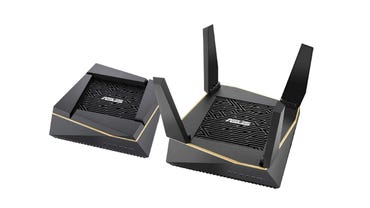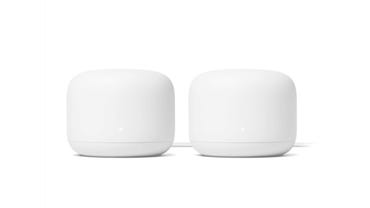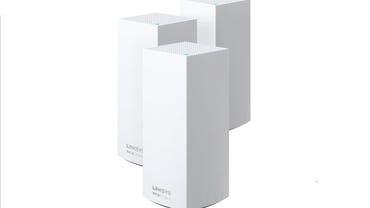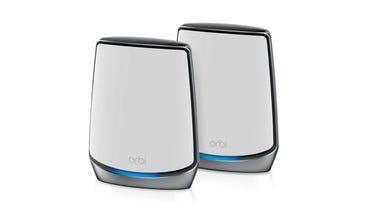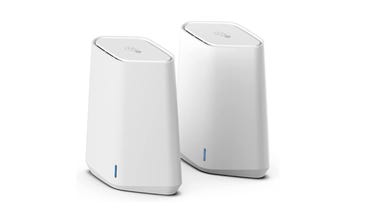The 5 best mesh Wi-Fi systems of 2022: Top routers
Demand for fast and reliable Wi-Fi is probably at an all-time high, as millions of people continue to work from home, relying on Zoom and other video conferencing apps to keep in touch with colleagues and clients. Many organizations are also finding that video calls reduce the need for business travel and client visits.
That increased reliance on Wi-Fi can reveal problems, though — especially in larger offices or homes, where the Wi-Fi signal may struggle to reach more distant rooms on other floors.
Instead of relying on a conventional Wi-Fi router and access points or range extenders, an alternative solution is to opt for a “mesh” networking system. Depending on the size of the building, mesh systems typically use a main router with a wired connection to a broadband modem, plus two or more wireless nodes that can be placed in different rooms or locations. The main router and the satellite nodes form their own “mesh” Wi-Fi network, covering a wider area and delivering greater speed and reliability than a conventional Wi-Fi router, even with extra access points or range extenders.
Most mesh systems are aimed at home users and marketed as easily-configured solutions for “whole-home Wi-Fi,” but some are particularly suitable for business users. These can include features such as multiple Ethernet ports or the ability to create several networks with different passwords. The latest mesh systems are now adopting the new Wi-Fi 6 standard (aka IEEE 802.11ax), which is certainly worth considering for businesses wanting to maximize the performance and flexibility of their Wi-Fi setups.
Asus AiMesh AX6100 Wi-Fi System (RT-AX92U)
Best mesh Wi-Fi system overall
Wi-Fi – tri-band Wi-Fi 6 | Speed – 1Gbps | Ports – RJ45 for Wan, 4 RJ45 for LAN, 2 USB | CPU – 1.8GHz, dual-core | Range – 5,500sq.ft
Asus claims that the AX6100 Wi-Fi System is the “world's first Wi-Fi 6 mesh system” — a claim that will doubtless be questioned by a few of its rivals. Nonetheless, the AiMesh AX6100 is an impressive mesh system that will be suitable for larger office buildings or public venues such as hotels or warehouses.
You can buy a single RT-AX92U router for $229.99, which offers tri-band Wi-Fi 6 (802.11ax) with a top speed of 6.1Gbps, as well as four Gigabit Ethernet ports for wired connections. Or, for more extensive Wi-Fi coverage, there's this twin-pack mesh system currently priced at $340.99. This covers areas of up to 5,500 square feet and uses one of the 5GHz bands as a 4.8Gbps “backhaul” that links the two routers in order to provide strong performance across the entire network.
The price is similar to that of other high-end Wi-Fi 6 systems, but Asus also offers its ZenWifi range of mesh systems for smaller offices or working from home, including new Wi-Fi 6 models such as the affordable ZenWifi AX Mini ($229.99 for a three-pack system).
Pros:
- Tri-band Wi-Fi 6
- Excellent wireless speeds
- 2 Pack
Cons:
- Older computers and devices not Wi-Fi 6 compatible
- Parental controls are clunky
Google Nest Wifi
Best for Google Assistant users
Wi-Fi – dual-band Wi-Fi 5 | Speed – 2200 Mbps | Ports – 4 Ethernet ports | CPU – N/A | Range – 4,400sq.ft
The original Google Wifi mesh system got very good reviews when it was first launched in 2016, and it helped to introduce mesh technology to a mainstream audience. The original Google Wi-Fi product has since been discontinued, but its successor emerged at the end of 2019 as part of the Google-owned Nest range of smart home devices.
The two-piece Nest Wi-Fi system shown here consists of a primary Nest Wi-Fi router (110mm diameter, 380g) which plugs into your broadband modem and a secondary Nest Wi-Fi point (102.2mm diameter, 350g). This system, which costs $229, provides dual-band 802.11s Wi-Fi (a mesh-oriented variation of standard 802.11ac) with the main router running at 2200Mbps. The Wi-Fi point runs at a more modest 1200Mbps, but that should still be more than adequate for streaming video, music, or Zoom calls with colleagues.
The Wi-Fi point also includes a speaker and microphone that support the voice-controlled Google Assistant. The two-piece system should be able to cover homes of up to 4,400 square feet (353 square meters), Google says, and you can purchase additional Wi-Fi points for $149 if required, each of which can cover an additional 1,600 square feet (149 square meters).
Pros:
- Dual band Wi-Fi
- Decent coverage range
- Voice-enabled
Cons:
Linksys Atlas Max 6E
Best splurge
Wi-Fi – tri-band Wi-Fi 6E | Speed – 5Gbps | Ports – 5Gbps WAN, 4 LAN, USB | CPU – 2.2GHz quad-core | Range – 9,000sq.ft
This is another “first,” with Linksys claiming to be the first company to ship a mesh system that supports the new Wi-Fi 6E standard, which can use the 6GHz frequency band in addition to existing 2.4GHz and 5.0GHz bands.
The tall, white plastic design looks very similar to Linksys's popular Velop mesh systems, and houses no less than 12 internal antennae, powered by a 2.2GHz quad-core processor. However, Linksys has clearly decided that this new Wi-Fi 6E system deserves a powerful new name befitting its high-performance credentials — hence the Linksys Atlas Max 6E.
Prices start at $499.99 for a single Atlas router, which provides tri-band Wi-Fi 6E with a top speed of 8.4Gbps (referred to as AXE8400). To match its high-end wireless speed, the Atlas also includes a 5-Gigabit Ethernet port for your internet connection, along with four Gigabit Ethernet ports for devices that require a wired connection. There's also a USB 3.0 port for connecting USB storage devices that can be shared on the network.
One Atlas router can cover an area of up to 3,000 square feet, with professional installation also available for business users. And, of course, the existing Velop range continues to be available for smaller offices or working from home.
Pros:
- Excellent coverage range
- Tri-band Wi-Fi
- Excellent wireless speeds
Cons:
Netgear Orbi Wi-Fi 6 (AX6000)
Best 2 piece system
Wi-Fi – tri-band Wi-Fi 6 | Speed – 6Gbps | Ports – 4 Gigabit Ethernet LAN each | CPU – 2.2GHz quad-core | Range – 5,000sq.ft
Netgear's Orbi range of mesh systems includes a variety of different designs and price points — including the Orbi Voice with a built-in smart-speaker that supports Amazon Alexa. The Orbi Wi-Fi 6, as the name suggests, employs the latest Wi-Fi 6 technology (aka 802.11ax).
The Orbi Wi-Fi 6 System AX6000 is very much a top-of-the-range mesh system, starting at $636.99 for a two-piece system comprised of a primary router and a secondary satellite. It offers impressive performance, though, with tri-band Wi-Fi capable of a combined top speed of 6Gbps — twice that of even the fastest Orbi systems based on Wi-Fi 5/802.11ac.
It's fast when it comes to wired connections too, with the primary router including a 2.5Gbps WAN port for a high-speed internet connection for office networks, along with four Gigabit Ethernet ports on both router and satellite for wired connections.
The two-piece system is designed to cover buildings of up to 5,000 square feet. There's also a three-piece system that covers up to 7,500 square feet, but it won't leave you much change from £1,000/$1,400.
Pros:
- Great coverage range
- Tri-band Wi-Fi 6
- Great wireless speeds
Cons:
Netgear Orbi Pro Wi-Fi 6 Mini (AX1800)
Most affordable mesh Wi-Fi system
Wi-Fi – dual-band Wi-Fi 6 | Speed – 6Gbps | Ports – 1 Gigabit Ethernet WAN, 3 Gigabit Ethernet LAN on Router, 4 Gigabit Ethernet LAN on satellite | CPU – N/A | Range – 4,000sq.ft
The tri-band Orbi Pro provides impressive Wi-Fi 6 performance, and is well-suited for organizations that need to manage multiple networks with different groups of users. It's pretty expensive, though, so Netgear recently introduced the more affordable dual-band Orbi Pro Wi-Fi 6 Mini for small businesses and remote workers.
Like other Orbi systems, the Mini consists of a primary router, with either one or two additional satellites that are used to extend the range of the mesh network. Prices start at $299.99 for a system consisting of a router and one satellite. Both devices provide dual-band Wi-Fi 6 (802.11ax) running at 1.8Gbps, which isn't going to win any awards, but is still perfectly adequate for Zoom calls and some after-hours Netflix video or gaming action. Each device has four Gigabit Ethernet ports for wired connections, although the primary router will need to use one of those ports for your internet connection.
Customers in the UK can also opt for a three-pack system that consists of a router and two satellites for £324.67 (ex. VAT, or £389.60 inc. VAT). The three-pack is currently priced at $239.99.
The Orbi Pro Mini is still relatively expensive for a dual-band system, but like other Orbi Pro models, the Mini stands out with additional features that cater specifically to business users. The key feature here is the ability to create four separate networks, each with its own password, which allows you to provide different levels of network access for admin and IT staff, guests who may be visiting your office or other public venues. And, when working from home, you can reserve one network to ensure that your Zoom calls aren't affected by family members bingeing on Netflix or the kids' gaming console.
Pros:
- Great coverage and wireless speeds
- Plenty of Ethernet ports
- Supports up to 40 simultaneous devices
Cons:
- VPN costs extra
- No USB ports
What is the best Wi-Fi mesh system?
Our pick for the best mesh Wi-Fi system is the Asus AiMesh AX6100. It offers tri-band Wi-Fi 6 connectivity, Gigabit Ethernet ports, and an impressive range of 5500 square feet.
|
Mesh Wi-Fi system |
Price |
Range |
Wi-Fi 6? |
|
Asus AiMesh AX6100 |
$300 |
5,500 sq.ft. |
Yes |
|
Google Nest Wifi |
$215 |
4,400 sq.ft. |
No |
|
Linksys Atlas Max 6E |
$1200 |
9,000 sq.ft. |
Yes |
|
Netgear Orbi AX6000 |
$690 |
5,000 sq.ft. |
Yes |
|
Netgear Orbi Pro Mini AX1800 |
$170 |
4,000 sq.ft. |
Yes |
Which is the right mesh system for you?
As mentioned, the size of your home or office building is the key factor in choosing a mesh system. The good news here is that even less-expensive mesh systems that still use older Wi-Fi 5 networking are fast enough to cope with Zoom calls, music, video, and gaming. However, more expensive Wi-Fi 6 systems can offer increased speed, and are also more efficient at streaming data to multiple connected devices all at the same time. So, as well as providing greater speed, Wi-Fi 6 systems are the best option for homes or offices that have lots of computers, mobile devices, and IoT devices that are in use all day long.
|
Choose this mesh Wi-Fi system.. |
If you need… |
|
Asus AiMesh AX6100 |
A fast and well-rounded tri-band Wi-Fi 6 mesh system |
|
Google Nest Wifi |
A system that is compatible with Google Assistant |
|
Linksys Atlas Max 6E |
A high-end mesh Wi-Fi system |
|
Netgear Orbi Wi-Fi 6 (AX6000) |
A dual piece mesh Wi-Fi system |
|
Netgear Orbi Pro Wi-Fi 6 Mini (AX1800) |
A budget-friendly mesh Wi-Fi system |
How did we choose these mesh Wi-Fi systems?
We've focused on two key areas, starting with affordable systems that simply provide greater range and reliability than a single, conventional Wi-Fi router. However, we've also included a number of high-end mesh systems — primarily using the new Wi-Fi 6 standard (802.11ax) — that provide greater performance than older Wi-Fi 5 (802.11ac) routers. As well as being suitable for homes and offices, these high-end systems also offer greater range and reliability for buildings such as warehouses and public venues such as restaurants and hotels.
What is a mesh Wi-Fi system?
A mesh Wi-Fi system acts similarly to Wi-Fi extenders: there is a main unit that connects to your modem and one or more satellite units that provide more consistent signals throughout your home. The difference between a mesh network and range extenders is that a mesh system is all part of the same network, so you don't have to worry about needing to switch networks as you move around your house.
Does a mesh Wi-Fi system replace my router?
A mesh system does, in a way, replace your router. But think of it as more like upgrading to a new model than being able to get rid of it altogether. Any mesh Wi-Fi system you buy will have a base router that connects to your modem and acts like your old router, sending signal out through your home. That signal is then picked up and rebroadcasted by the satellite routers, creating a larger signal range as well as stronger signals for streaming and gaming.
How many mesh devices do I need?
A two-piece mesh should be able to cover homes or offices up to 4,000 – 5,000 square feet (check the manufacturer's specifications to see what they recommend). Buildings or outdoor venues larger than 5,000 square feet may need another satellite device.
Why should you buy a mesh system?
A single, standalone router is generally adequate for smaller offices, or single-story homes with one or two bedrooms. But if you have rooms on other floors, or thick walls that can block your Wi-Fi signal, then you may experience “dead zones” that have weak Wi-Fi. A mesh system uses several devices — usually a main router and one or more satellite nodes — in different locations to extend the Wi-Fi signal beyond the range of a single router.
What about range extenders?
If you just have one or two rooms where the Wi-Fi is weak, then a low-cost “range extender” may be able to boost the Wi-Fi signal just in those rooms, with prices starting as low as £50 ($69). However, multi-device mesh Wi-Fi systems are designed to provide a more extensive Wi-Fi network that covers your entire home or office.
Are there alternative mesh Wi-Fi systems to consider?
Below is an honorable mention:

